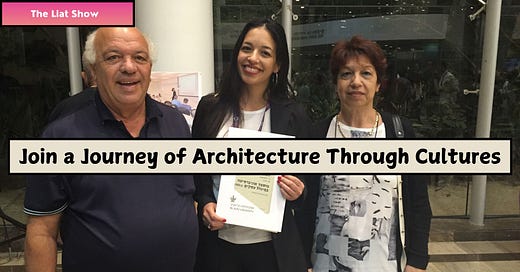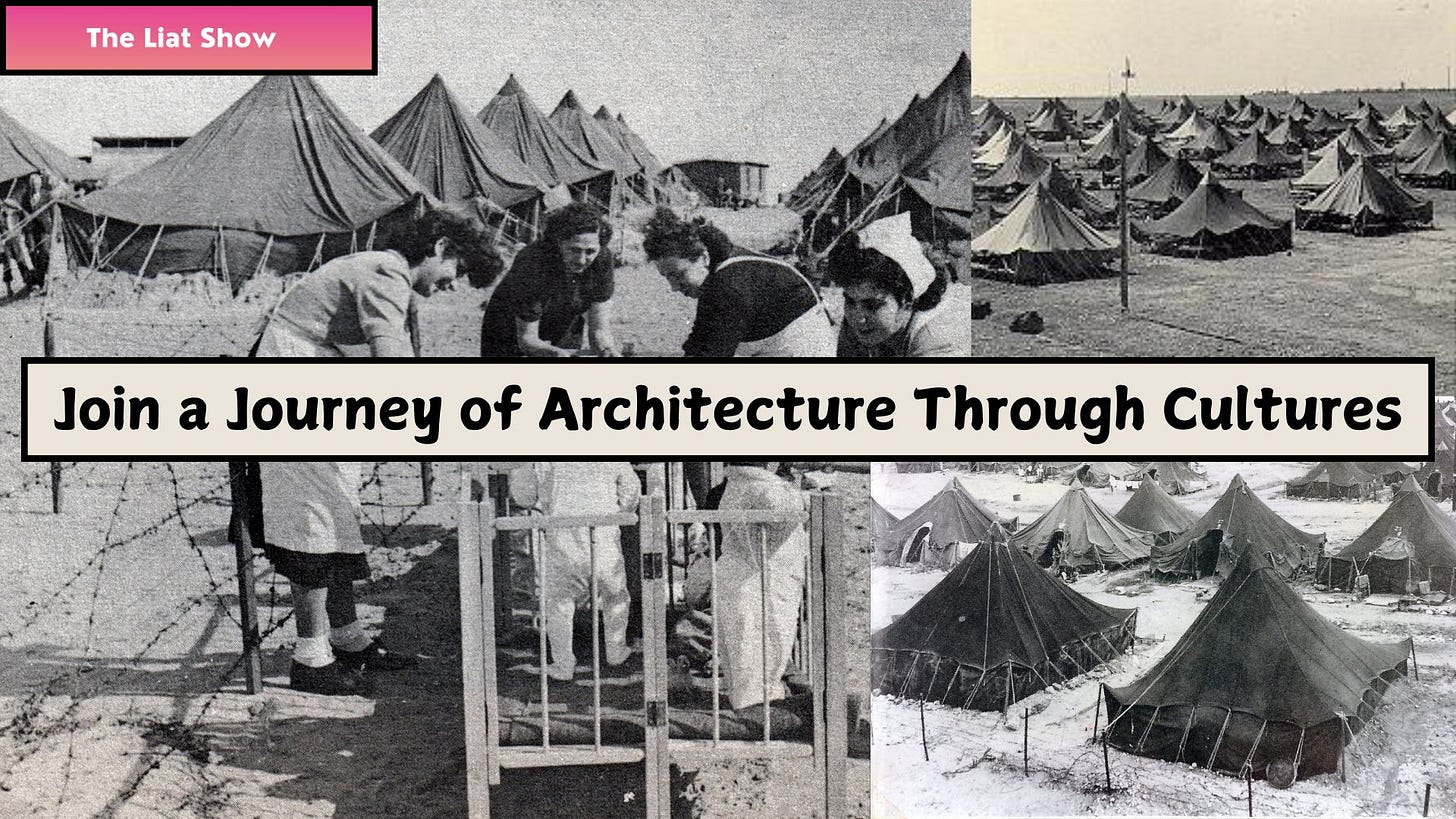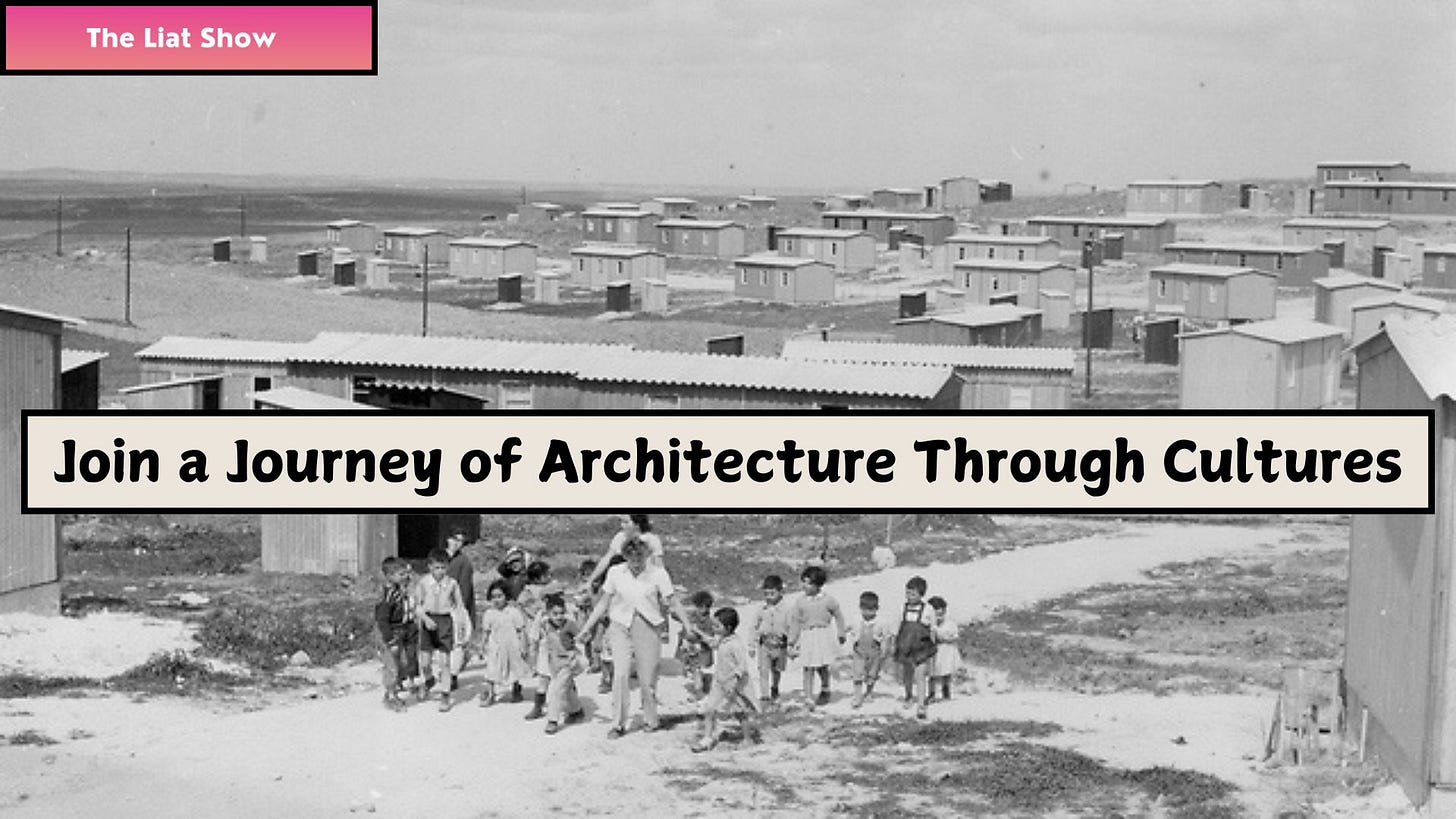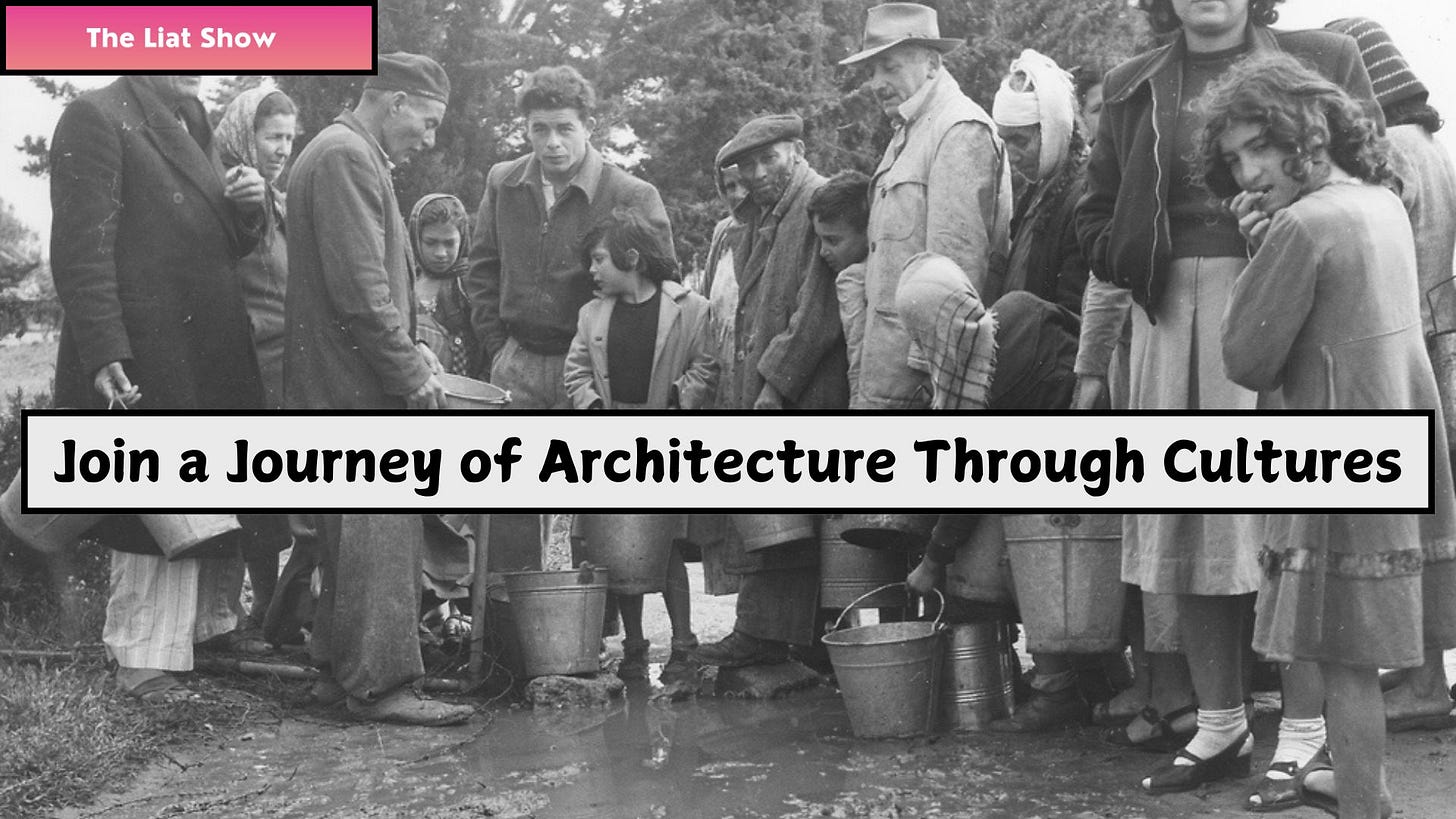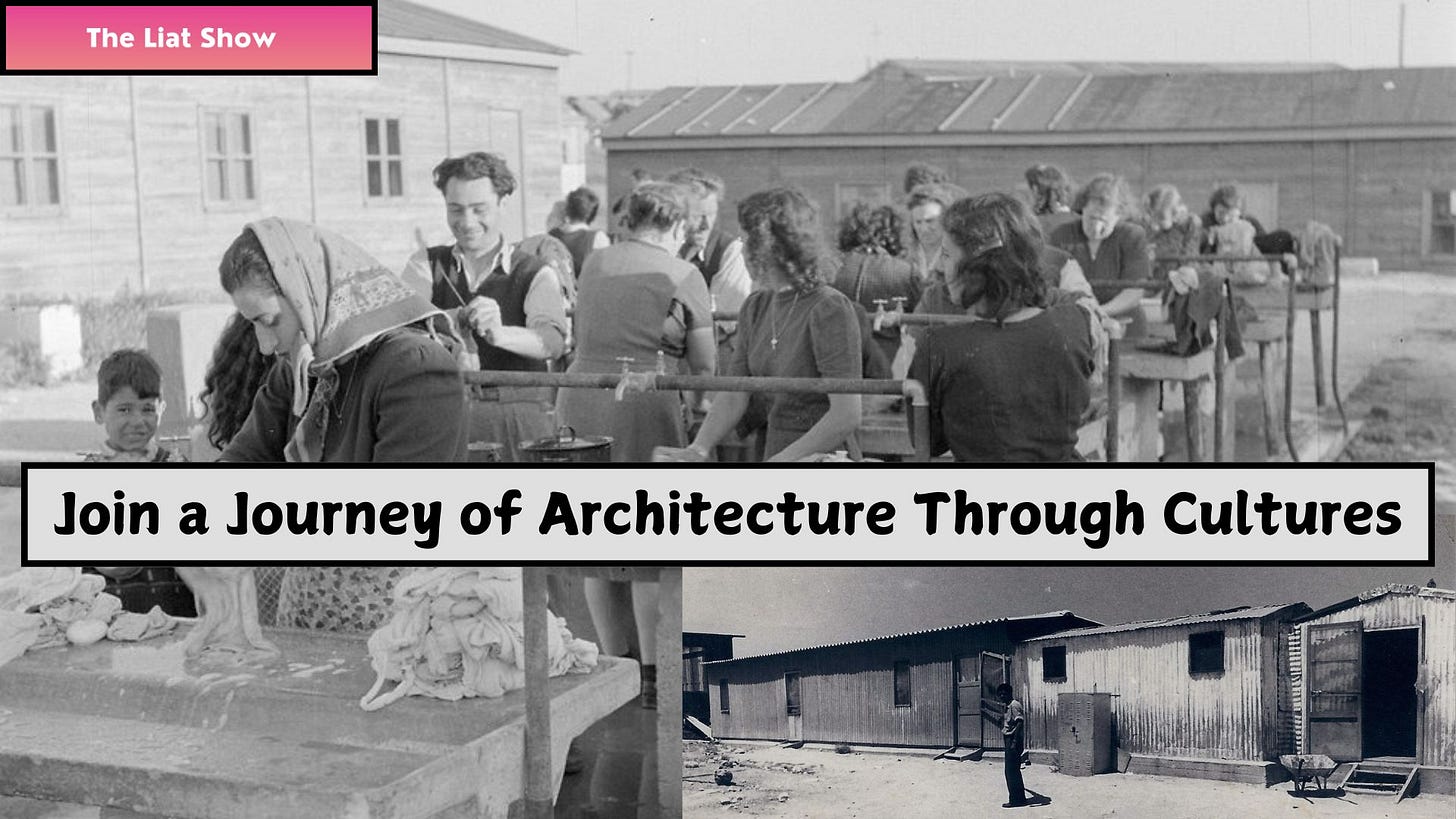From Transit Camps to Triumph: The Refugees Who Built a New Future
A Story Unfolding Across Timelines.
Current Time.
A Quick Recap
In this series, I am sharing my conversations with my father and inviting you to be part of them. This new installment will focus on the pre-state period and the early days of Israel when the country faced the challenge of housing almost a million immigrants who arrived with nothing but the clothes they wore.
In this installment, we'll focus on the development of large-scale residential projects. We will look at how they were built, what made them possible, and how they shaped the lives of the people who lived in them.
Are you ready? Let's dive in.
Liat: We ended the session with the period after World War II, where the urgent need for government-led housing initiatives resurfaced due to widespread destruction.
But before we start today’s session, I want to share with you my vision. Followers who read my interview with
were briefly exposed to the vision. Now, I feel comfortable sharing this vision with you. Although you are my father, I was embarrassed to share my dream with you.Nissim: Really? Why?
Liat: Because you probably would have said that I’m either crazy, a fool, or the dumbest, most ridiculous, brainless entrepreneur you have ever met.
Nissim: No, I wouldn’t.
Liat: Yes, you would. You would have said that my idea is the most ignorant entrepreneurial idea ever and probably would have made jokes about it and me.
Nissim: Stop mumbling. What is it? What is this big idea?
Liat: Well, I want to build an education system based on the entertainment industry that will function as the compulsory education system of the future. Since we spend so much time on social media, this education system of the future needs to be plugged into social media platforms.
Nissim: What?
Liat: Yes, it’s too complicated to explain it for the first time. So, let me describe how our following sessions would look in this future school. Technically, these sessions would be the equivalent of classes; however, they would need to be adapted to online.
Let’s imagine this together, starting with today’s session. What exists we’ll use, but what needs to be developed, we’ll imagine together, and soon enough, we’ll find companies that have all the products or services we need to build this school.
Nissim: You know that I’m 70 years old, right? Could I manage to keep up with all this technology? I barely manage with Facebook and Instagram.
Liat: I have the superpowers of a tech support and customer success team since 1998, so I know we can work it out.
Nissim: Customer success team? Is there also a customer failure team?
Liat: The customer failure team is the default team in all startups, often known as the founders team. Only companies that succeed in building a working product and gaining initial customers reach the point where they can establish a customer success team.
Nissim: Okay. What exactly does it mean?
Liat: Each session we have, which I also refer to as an episode, would be a class but with a twist. Basically, these classes include practices from the traditional education system and would be adapted to social media. I’ll explain it further as we progress, but to get a sense of how it works, let’s jump into deep water together and see what happens.
So far, I have just documented our conversations, but now, let's take it to the next phase of creating an online class that travels across timelines. To illustrate this class, think of me as a student in our classroom. Currently, I’m the only student here, but in the future, I imagine it to be a dynamic hybrid class that includes live streaming, and people would be able to join it at their own convenience and still participate in the class.
I know, it's hard to even imagine it. That is usually what happens when explaining an innovative idea. Could you imagine Facebook 20 years ago if I had explained it to you? Most people wouldn’t. So, no worries, it will be okay. Trust me, I’m an engineer.
Nissim: I’m an architect.
Liat: I know, and so do my readers. You’re already famous, and soon, I’ll make you a global star!
Let’s dive in. I remind you that we ended our last session with the urgent need to find housing solutions following the widespread destruction of World War II and the baby boom. The situation in Israel was different since the British Mandate ended, and David Ben-Gurion declared the establishment of the State of Israel.
Nissim: Right. Let’s continue from that point. So, if this is my class and you are my student, I’ll start by welcoming you.
Good morning, student! It’s great that you showed up on time to class. Since I know your history, I would expect you to arrive at least 20 minutes late, but you surprised me today. Well done!
In today’s class, we’ll dive into the first years of the State of Israel and the severe housing crisis following the mass immigration to the country.
The Declaration of Independence and the Demographic Challenge
With the declaration of independence in 1948, Israel faced a massive demographic challenge. Large waves of immigration flowed into the country from all over the world. Holocaust survivors and European Jewish refugees who lost their entire families and possessions during World War II. In parallel to European immigration, a flood of Jewish refugees from Muslim countries such as Morocco, Tunisia, Algeria, Yemen, and Iraq arrived in Israel after they were forced to flee following Israel’s victory in the War of Independence.
When the news reached Muslim countries that Israel had managed to beat the armies of five countries, anger toward the Jewish population intensified, and they were forced to escape, leaving behind everything they owned.
These waves of immigrants led to the arrival of about a million immigrants in the first decade of Israel’s establishment. No country in the world had ever managed to absorb similar numbers of immigrants and survived. By the end of the 1950s, Israel’s population had tripled from 650,000 to 1.8 million, creating an urgent need for fast and affordable housing solutions.
The vast majority of immigrants were refugees who arrived with no money, no belongings, no housing solutions, and no family. They arrived in a new state still in its infancy, which lacked the financial means to support this influx of new arrivals. In this situation, young Israel had to figure it out and rapidly build thousands of housing units to accommodate these immigrants.
The Ministry of Labor and Construction (Division 95) was established upon the declaration of independence, with the construction and housing sector assigned to its planning division. When the permanent government was formed in 1949, the planning division was split between the Prime Minister’s Office and the Ministry of the Interior. However, in 1950, the responsibility for the housing division was given to the Ministry of Labor and National Insurance.
Initially, housing solutions were improvised by whatever was available, including the use of abandoned buildings, temporary housing units, and the establishment of transit camps to bridge the gap. However, it became clear that these solutions were insufficient, and the state began planning and building new residential neighborhoods.
The planning division’s main task was to house hundreds of thousands of new immigrants who lived in the Ma’abarot (transit camps), build infrastructure for factories, pave roads, and develop the areas to establish new towns and neighborhoods within established cities.
Initial Housing Solutions
The Transit Camps — A Temporary but Necessary Solution
The first and immediate solution of the planning division was to establish transit camps, which were temporary housing solutions, also known by the name Ma’abara (Ma’abara - singular, Ma’abarot - plural) to absorb all new immigrants.
The first Ma’abarot mainly consisted of large tents that accommodated several families. Later, some Ma’abarot that were established saw slight improvements and consisted of tin huts and simple wooden shacks.
The goal of these transit camps was to provide an immediate response to the housing crisis, but they turned out to be a temporary solution that lasted for several years and could not meet long-term needs. According to archival data from the Ministry of Construction and Housing, by 1951, about 250,000 immigrants had lived in transit camps, which was nearly a quarter of Israel’s population at that time.
The Ma’abarot’s housing was improvised using whatever materials were available, which directly affected the quality of life, health, and cultural life of the residents. Unfortunately, living conditions in these camps were harsh. There was barely any running water, poor sewage infrastructure, and cramped housing conditions. The toilets, showers, and faucets for running water were placed at specific spots within the camp, while the houses themselves were mainly simple structures that contained one large hall or a divider for separation. However, there was no infrastructure for running water inside the shacks or huts.
In addition to the lack of basic infrastructure like running water and sewage systems, which affected the residents' health, social and cultural challenges arose. The merging of Jewish communities from different countries and ethnic backgrounds created clashes between traditions, cultures, and ways of life. These conflicts sometimes escalated into violence and, in some cases, even crime.
However, the main problem for the residents of these camps was unemployment. Many of the new immigrants had skills and professions that were not in demand, and because of language barriers, they couldn’t easily train for jobs that were required at that time.
The professions in demand included builders and various trades in the construction industry (contractors, plumbers, electricians, carpenters, tilers, etc.), along with architects, engineers, and factory workers. Immigrants who arrived from Europe were often more educated and had skills that the young country needed to develop and expand. Meanwhile, many immigrants from Muslim countries were mostly uneducated, didn’t know how to read or write, and had professions that were not essential at that time, such as traders.
Moreover, the residents of the Ma’abarot were a mix of Jewish communities from different countries who spoke different languages. As a result, structuring an education system was a major challenge since the children spoke various languages, and what connected them was Hebrew, but only a limited form of Hebrew, as many had only learned it from the Bible.
In this chaotic reality, the government had to find temporary housing solutions while simultaneously building permanent housing, creating employment opportunities, training immigrants in needed professions, establishing an education system to support children who spoke different languages, and finding a solution to feed all these poor people, most of whom were refugees with no money.
Mission Impossible.
Everyone said so. But David Ben-Gurion declared that the country would accept every Jew who wanted to come, and he did it.
These Ma’abarot remain an open wound to this day, and some define them as a national trauma. However, despite all the struggles and difficulties, the bottom line is that Israel managed to absorb this massive wave of immigrants and achieved a success that no other country had ever accomplished.
Liat: Wow.
Nissim: Yes. That was today’s class. Thank you for coming. We'll resume tomorrow.
Liat: Come on! You’re leaving me hanging!
Nissim: You wanted these classes to be adapted for online, and there are already more than 1800 words here, which means it takes about 9 minutes to read this in the middle of a workday. So I think that’s the limit for the amount of time people can spend between tasks. They should go back to work and return tomorrow.
Liat: Okay, see you in the next session.
Please fasten your seatbelts and subscribe.
Unlock my potential to write the next great chapter in the most extraordinary story ever told. Your support would make a big difference in taking this journey to the next level.
Follow me on My Journey to Infinity to find out. It will be more beautiful than you could ever imagine.
Liat
In this journey, I weave together episodes from my life with the rich tapestry of Israeli culture through music, food, arts, entrepreneurship, fiction, and more. I write over the weekends and evenings and publish these episodes as they unfold, almost like a live performance.
Each episode is part of a set focused on a specific topic, though sometimes I release standalone episodes. A set is released over several days to make it easier for you to read during your busy workday. If one episode catches your attention, make sure to read the entire set to get the whole picture. Although these episodes are released in sets, you can read the entire newsletter from the beginning, as it flows smoothly, like music to your ears - or, in this case, your eyes.


